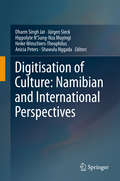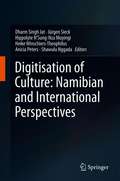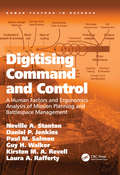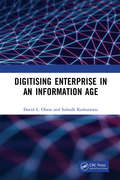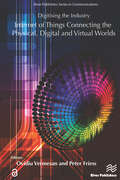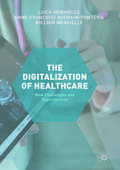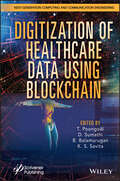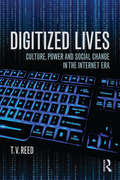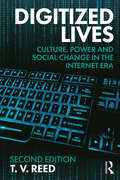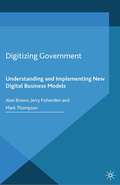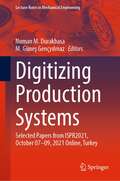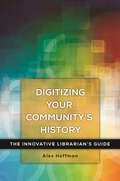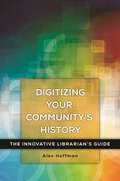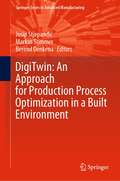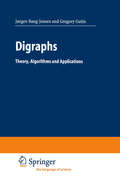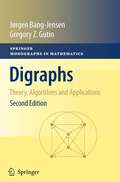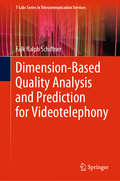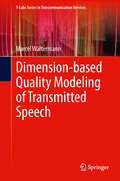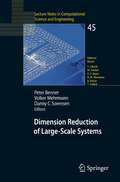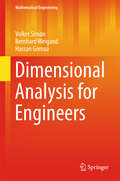- Table View
- List View
Digitisation of Culture: Namibian and International Perspectives
by Dharm Singh Jat Jürgen Sieck Hippolyte N'Sung-Nza Muyingi Heike Winschiers-Theophilus Anicia Peters Shawulu NggadaThis book explores the digitization of culture as a means of experiencing and understanding cultural heritage in Namibia and from international perspectives. It provides various views and perspectives on the digitization of culture, the goal being to stimulate further research, and to rapidly disseminate related discoveries. Aspects covered here include: virtual and augmented reality, audio and video technology, art, multimedia and digital media integration, cross-media technologies, modeling, visualization and interaction as a means of experiencing and grasping cultural heritage. Over the past few decades, digitization has profoundly changed our cultural experience, not only in terms of digital technology-based access, production and dissemination, but also in terms of participation and creation, and learning and partaking in a knowledge society. Computing researchers have developed a wealth of new digital systems for preserving, sharing and interacting with cultural resources. The book provides important information and tools for policy makers, knowledge experts, cultural and creative industries, communication scientists, professionals, educators, librarians and artists, as well as computing scientists and engineers conducting research on cultural topics.
Digitisation Of Culture: Namibian And International Perspectives (PDF)
by Dharm Singh Jat Jürgen Sieck Hipollyte Muyingi Heike Winschiers-Theophilus Anicia Peters Shawulu Nggada Hippolyte N'Sung-Nza MuyingiThis book explores the digitization of culture as a means of experiencing and understanding cultural heritage in Namibia and from international perspectives. It provides various views and perspectives on the digitization of culture, the goal being to stimulate further research, and to rapidly disseminate related discoveries. Aspects covered here include: virtual and augmented reality, audio and video technology, art, multimedia and digital media integration, cross-media technologies, modeling, visualization and interaction as a means of experiencing and grasping cultural heritage. Over the past few decades, digitization has profoundly changed our cultural experience, not only in terms of digital technology-based access, production and dissemination, but also in terms of participation and creation, and learning and partaking in a knowledge society. Computing researchers have developed a wealth of new digital systems for preserving, sharing and interacting with cultural resources. The book provides important information and tools for policy makers, knowledge experts, cultural and creative industries, communication scientists, professionals, educators, librarians and artists, as well as computing scientists and engineers conducting research on cultural topics.
Digitising Command and Control: A Human Factors and Ergonomics Analysis of Mission Planning and Battlespace Management (Human Factors in Defence)
by Neville A. Stanton Daniel P. Jenkins Paul M. Salmon Guy H. Walker Kirsten M. Revell Laura A. RaffertyThis book presents a human factors and ergonomics evaluation of a digital Mission Planning and Battle-space Management (MP/BM) system. An emphasis was placed on the activities at the Brigade (Bde) and the Battle Group (BG) headquarters (HQ) levels. The analysts distributed their time evenly between these two locations. The human factors team from Brunel University, as part of the HFI DTC, undertook a multi-faceted approach to the investigation, including: - observation of people using the traditional analogue MP/BM processes in the course of their work - cognitive work analysis of the digital MP/BM system - analysis of the tasks and goal structure required by the digital MP/BM - assessment against a usability questionnaire - analysis of the distributed situation awareness - an environmental survey. The book concludes with a summary of the research project's findings and offers many valuable insights. For example, the recommendations for short-term improvements in the current generation of digital MP/BM system address general design improvements, user-interface design improvements, hardware improvements, infrastructure improvements and support improvements. In looking forward to the next generation digital MP/BM systems, general human factors design principles are presented and human factors issues in digitising mission planning are considered.
Digitising Command and Control: A Human Factors and Ergonomics Analysis of Mission Planning and Battlespace Management (Human Factors in Defence)
by Neville A. Stanton Daniel P. Jenkins Paul M. Salmon Guy H. Walker Kirsten M. Revell Laura A. RaffertyThis book presents a human factors and ergonomics evaluation of a digital Mission Planning and Battle-space Management (MP/BM) system. An emphasis was placed on the activities at the Brigade (Bde) and the Battle Group (BG) headquarters (HQ) levels. The analysts distributed their time evenly between these two locations. The human factors team from Brunel University, as part of the HFI DTC, undertook a multi-faceted approach to the investigation, including: - observation of people using the traditional analogue MP/BM processes in the course of their work - cognitive work analysis of the digital MP/BM system - analysis of the tasks and goal structure required by the digital MP/BM - assessment against a usability questionnaire - analysis of the distributed situation awareness - an environmental survey. The book concludes with a summary of the research project's findings and offers many valuable insights. For example, the recommendations for short-term improvements in the current generation of digital MP/BM system address general design improvements, user-interface design improvements, hardware improvements, infrastructure improvements and support improvements. In looking forward to the next generation digital MP/BM systems, general human factors design principles are presented and human factors issues in digitising mission planning are considered.
Digitising Enterprise in an Information Age
by David L. Olson Subodh KesharwaniDigitising Enterprise in an Information Age is an effort that focuses on a very vast cluster of Enterprises and their digitising technology involvement and take us through the road map of the implementation process in them, some of them being ICT, Banking, Stock Markets, Textile Industry & ICT, Social Media, Software Quality Assurance, Information Systems Security and Risk Management, Employee Resource Planning etc. It delves on increased instances of cyber spamming and the threat that poses to e-Commerce and Banking and tools that help and Enterprise toward of such threats. To quote Confucius, “As the water shapes itself to the vessel that contains it, so does a wise man adapts himself to circumstances.” And the journey of evolution and progression will continue and institutions and enterprises will continue to become smarter and more and more technology savvy. Enterprises and businesses across all genre and spectrum are trying their level best to adopt to change and move on with the changing requirements of technology and as enterprises and companies upgrade and speed up their digital transformations and move their outdate heirloom systems to the cloud, archaic partners that don't keep up will be left behind. Note: T&F does not sell or distribute the Hardback in India, Pakistan, Nepal, Bhutan, Bangladesh and Sri Lanka.
Digitising Enterprise in an Information Age
by David L. Olson Subodh KesharwaniDigitising Enterprise in an Information Age is an effort that focuses on a very vast cluster of Enterprises and their digitising technology involvement and take us through the road map of the implementation process in them, some of them being ICT, Banking, Stock Markets, Textile Industry & ICT, Social Media, Software Quality Assurance, Information Systems Security and Risk Management, Employee Resource Planning etc. It delves on increased instances of cyber spamming and the threat that poses to e-Commerce and Banking and tools that help and Enterprise toward of such threats. To quote Confucius, “As the water shapes itself to the vessel that contains it, so does a wise man adapts himself to circumstances.” And the journey of evolution and progression will continue and institutions and enterprises will continue to become smarter and more and more technology savvy. Enterprises and businesses across all genre and spectrum are trying their level best to adopt to change and move on with the changing requirements of technology and as enterprises and companies upgrade and speed up their digital transformations and move their outdate heirloom systems to the cloud, archaic partners that don't keep up will be left behind. Note: T&F does not sell or distribute the Hardback in India, Pakistan, Nepal, Bhutan, Bangladesh and Sri Lanka.
Digitising the Industry Internet of Things Connecting the Physical, Digital and VirtualWorlds
by Ovidiu Vermesan Peter FriessThis book provides an overview of the current Internet of Things (IoT) landscape, ranging from the research, innovation and development priorities to enabling technologies in a global context. A successful deployment of IoT technologies requires integration on all layers, be it cognitive and semantic aspects, middleware components, services, edge devices/machines and infrastructures. It is intended to be a standalone book in a series that covers the Internet of Things activities of the IERC - Internet of Things European Research Cluster from research to technological innovation, validation and deployment. The book builds on the ideas put forward by the European Research Cluster and the IoT European Platform Initiative (IoT-EPI) and presents global views and state of the art results on the challenges facing the research, innovation, development and deployment of IoT in the next years. The IoT is bridging the physical world with virtual world and requires sound information processing capabilities for the "digital shadows" of these real things. The research and innovation in nanoelectronics, semiconductor, sensors/actuators, communication, analytics technologies, cyber-physical systems, software, swarm intelligent and deep learning systems are essential for the successful deployment of IoT applications. The emergence of IoT platforms with multiple functionalities enables rapid development and lower costs by offering standardised components that can be shared across multiple solutions in many industry verticals. The IoT applications will gradually move from vertical, single purpose solutions to multi-purpose and collaborative applications interacting across industry verticals, organisations and people, being one of the essential paradigms of the digital economy. Many of those applications still have to be identified and involvement of end-users including the creative sector in this innovation is crucial. The IoT applications and deployments as integrated building blocks of the new digital economy are part of the accompanying IoT policy framework to address issues of horizontal nature and common interest (i.e. privacy, end-to-end security, user acceptance, societal, ethical aspects and legal issues) for providing trusted IoT solutions in a coordinated and consolidated manner across the IoT activities and pilots. In this, context IoT ecosystems offer solutions beyond a platform and solve important technical challenges in the different verticals and across verticals. These IoT technology ecosystems are instrumental for the deployment of large pilots and can easily be connected to or build upon the core IoT solutions for different applications in order to expand the system of use and allow new and even unanticipated IoT end uses. Technical topics discussed in the book include: • Introduction• Digitising industry and IoT as key enabler in the new era of Digital Economy• IoT Strategic Research and Innovation Agenda• IoT in the digital industrial context: Digital Single Market• Integration of heterogeneous systems and bridging the virtual, digital and physical worlds• Federated IoT platforms and interoperability• Evolution from intelligent devices to connected systems of systems by adding new layers of cognitive behaviour, artificial intelligence and user interfaces.• Innovation through IoT ecosystems• Trust-based IoT end-to-end security, privacy framework• User acceptance, societal, ethical aspects and legal issues• Internet of Things Applications
Digitising the Industry Internet of Things Connecting the Physical, Digital and VirtualWorlds
This book provides an overview of the current Internet of Things (IoT) landscape, ranging from the research, innovation and development priorities to enabling technologies in a global context. A successful deployment of IoT technologies requires integration on all layers, be it cognitive and semantic aspects, middleware components, services, edge devices/machines and infrastructures. It is intended to be a standalone book in a series that covers the Internet of Things activities of the IERC - Internet of Things European Research Cluster from research to technological innovation, validation and deployment. The book builds on the ideas put forward by the European Research Cluster and the IoT European Platform Initiative (IoT-EPI) and presents global views and state of the art results on the challenges facing the research, innovation, development and deployment of IoT in the next years. The IoT is bridging the physical world with virtual world and requires sound information processing capabilities for the "digital shadows" of these real things. The research and innovation in nanoelectronics, semiconductor, sensors/actuators, communication, analytics technologies, cyber-physical systems, software, swarm intelligent and deep learning systems are essential for the successful deployment of IoT applications. The emergence of IoT platforms with multiple functionalities enables rapid development and lower costs by offering standardised components that can be shared across multiple solutions in many industry verticals. The IoT applications will gradually move from vertical, single purpose solutions to multi-purpose and collaborative applications interacting across industry verticals, organisations and people, being one of the essential paradigms of the digital economy. Many of those applications still have to be identified and involvement of end-users including the creative sector in this innovation is crucial. The IoT applications and deployments as integrated building blocks of the new digital economy are part of the accompanying IoT policy framework to address issues of horizontal nature and common interest (i.e. privacy, end-to-end security, user acceptance, societal, ethical aspects and legal issues) for providing trusted IoT solutions in a coordinated and consolidated manner across the IoT activities and pilots. In this, context IoT ecosystems offer solutions beyond a platform and solve important technical challenges in the different verticals and across verticals. These IoT technology ecosystems are instrumental for the deployment of large pilots and can easily be connected to or build upon the core IoT solutions for different applications in order to expand the system of use and allow new and even unanticipated IoT end uses. Technical topics discussed in the book include: • Introduction• Digitising industry and IoT as key enabler in the new era of Digital Economy• IoT Strategic Research and Innovation Agenda• IoT in the digital industrial context: Digital Single Market• Integration of heterogeneous systems and bridging the virtual, digital and physical worlds• Federated IoT platforms and interoperability• Evolution from intelligent devices to connected systems of systems by adding new layers of cognitive behaviour, artificial intelligence and user interfaces.• Innovation through IoT ecosystems• Trust-based IoT end-to-end security, privacy framework• User acceptance, societal, ethical aspects and legal issues• Internet of Things Applications
The Digitization of Healthcare: New Challenges and Opportunities
by Loick Menvielle Anne-Françoise Audrain-Pontevia William MenvielleCombining conceptual, pragmatic and operational approaches, this edited collection addresses the demand for knowledge and understanding of IT in the healthcare sector. With new technology outbreaks, our vision of healthcare has been drastically changed, switching from a ‘traditional’ path to a digitalized one. Providing an overview of the role of IT in the healthcare sector, The Digitization of Healthcare illustrates the potential benefits and challenges for all those involved in delivering care to the patient. The incursion of IT has disrupted the value chain and changed business models for companies working in the health sector, and also raised ethical issues and new paradigms about delivering care. This book illustrates the rise of patient empowerment through the development of patient communities such as PatientLikeMe, and medical collaborate platforms such as DockCheck, thus providing a necessary tool to patients, caregivers and academics alike.
Digitization of Healthcare Data using Blockchain
by T. Poongodi D. Sumathi B. Balamurugan K. S. SavitaDIGITIZATION OF HEALTHCARE DATA USING BLOCKCHAIN The book gives a detailed description of the integration of blockchain technology for Electronic Health Records and provides the research challenges to consider in various disciplines such as supply chain, drug discovery, and data management. The aim of the book is to investigate the concepts of blockchain technology and its association with the recent development and advancements in the medical field. Moreover, it focuses on the integration of workflow strategies like NLP, and AI which could be adopted for boosting the clinical documentation and electronic healthcare records (EHR) usage by bringing down the physician EHR data entry. Also, the book covers the usage of smart contracts for securing patient records. Digitization of Healthcare Data Using Blockchain presents the practical implementations that deal with developing a web framework for building highly usable healthcare applications, a simple blockchain-powered EHR system. Audience Researchers in information technology, artificial intelligence, electronics engineering, medical informatics, as well as policymakers and healthcare providers and management systems.
Digitization of Healthcare Data using Blockchain
by T. Poongodi D. Sumathi B. Balamurugan K. S. SavitaDIGITIZATION OF HEALTHCARE DATA USING BLOCKCHAIN The book gives a detailed description of the integration of blockchain technology for Electronic Health Records and provides the research challenges to consider in various disciplines such as supply chain, drug discovery, and data management. The aim of the book is to investigate the concepts of blockchain technology and its association with the recent development and advancements in the medical field. Moreover, it focuses on the integration of workflow strategies like NLP, and AI which could be adopted for boosting the clinical documentation and electronic healthcare records (EHR) usage by bringing down the physician EHR data entry. Also, the book covers the usage of smart contracts for securing patient records. Digitization of Healthcare Data Using Blockchain presents the practical implementations that deal with developing a web framework for building highly usable healthcare applications, a simple blockchain-powered EHR system. Audience Researchers in information technology, artificial intelligence, electronics engineering, medical informatics, as well as policymakers and healthcare providers and management systems.
Digitized Lives: Culture, Power, and Social Change in the Internet Era
by T. V. ReedIn a remarkably short period of time the Internet and associated digital communication technologies have deeply changed the way millions of people around the globe live their lives. But what is the nature of that impact? In chapters examining a broad range of issues—including sexuality, politics, education, race, gender relations, the environment, and social protest movements—Digitized Lives seeks answers to these central questions: What is truly new about so-called "new media," and what is just hype? How have our lives been made better or worse by digital communication technologies? In what ways can these devices and practices contribute to a richer cultural landscape and a more sustainable society? Cutting through the vast—and often contradictory—literature on these topics, Reed avoids both techno-hype and techno-pessimism, offering instead succinct, witty and insightful discussions of how digital communication is impacting our lives and reshaping the major social issues of our era. The book argues that making sense of digitized culture means looking past the glossy surface of techno gear to ask deeper questions about how we can utilize technology to create a more socially, politically, and economically just world. Companion website available at: culturalpolitics.net/digital_cultures
Digitized Lives: Culture, Power, and Social Change in the Internet Era
by T. V. ReedIn a remarkably short period of time the Internet and associated digital communication technologies have deeply changed the way millions of people around the globe live their lives. But what is the nature of that impact? In chapters examining a broad range of issues—including sexuality, politics, education, race, gender relations, the environment, and social protest movements—Digitized Lives seeks answers to these central questions: What is truly new about so-called "new media," and what is just hype? How have our lives been made better or worse by digital communication technologies? In what ways can these devices and practices contribute to a richer cultural landscape and a more sustainable society? Cutting through the vast—and often contradictory—literature on these topics, Reed avoids both techno-hype and techno-pessimism, offering instead succinct, witty and insightful discussions of how digital communication is impacting our lives and reshaping the major social issues of our era. The book argues that making sense of digitized culture means looking past the glossy surface of techno gear to ask deeper questions about how we can utilize technology to create a more socially, politically, and economically just world. Companion website available at: culturalpolitics.net/digital_cultures
Digitized Lives: Culture, Power and Social Change in the Internet Era
by T. V. ReedIn chapters examining a broad range of issues—including sexuality, politics, education, race, gender relations, the environment and social protest movements—Digitized Lives argues that making sense of digitized culture means looking past the glossy surface of techno gear to ask deeper questions about how we can utilize technology to create a more socially, politically and economically just world. This second edition includes important updates on mobile and social media, examining how new platforms and devices have altered how we interact with digital technologies in an allegedly ‘post-truth’ era. A companion website (www.culturalpolitics.net/digital_cultures) includes links to online articles and useful websites, as well as a bibliography of offline resources, and more.
Digitizing Government: Understanding and Implementing New Digital Business Models (Business in the Digital Economy)
by A. Brown J. Fishenden M. ThompsonFor businesses large and small, investment in digital technologies is now a priority essential for success. Digitizing Government provides practical advice for understanding and implementing digital transformation to increase business value and improve client engagement, and features case studies from the private and public sectors.
Digitizing Production Systems: Selected Papers from ISPR2021, October 07-09, 2021 Online, Turkey (Lecture Notes in Mechanical Engineering)
by Numan M. Durakbasa M. Güneş GençyılmazThis book contains selected papers from International Symposium for Production Research 2021, held on October 7–9, 2021, online, Turkey. The book reports recent advances in production engineering and operations. It explores topics including production research;production management; operations management;industry 4.0;industrial engineering;mechanical engineering;engineering management; andoperational research. Presenting real-life applications, case studies, and mathematical models, this book is of interest to researchers, academics, and practitioners in the field of production and operation engineering. It provides both the results of recent research and practical solutions to real-world problems.
Digitizing Your Community's History: The Innovative Librarian's Guide (Innovative Librarian's Guide)
by Alex HoffmanFollow the blueprint in this book to launch a library DIY community history digitization program—one that provides the access and fosters engagement with patrons to sustain the program over time.Internet technologies have enabled anyone to tell their story—and to find out their own unknown story. Libraries are seeing increased interest in community and family history and in genealogy, as well as heightened demand for access to personal and community history materials in digital format. The opportunity exists for libraries to benefit their communities by providing these in-demand, digitized historical materials optimized for researchers at the individual level. Digitizing Your Community's History: The Innovative Librarian's Guide provides you with step-by-step directions for launching a DIY digitization program for personal and community historical materials. It covers the process of setting up a digitization program, training customers to use the equipment, best practices for storing digitized material, and tips for engaging the community in local history, such as ideas for exhibiting materials and programs for genealogy and family history. Just as importantly, the author addresses how to explain the benefits of programs like these to library stakeholders and supplies recommendations on sustaining library community history programs through access and engagement. The book also provides supplemental materials that include templates and programming ideas, lists of recommended software and apps, and recommended specifications for equipment and for file storage.
Digitizing Your Community's History: The Innovative Librarian's Guide (Innovative Librarian's Guide)
by Alex HoffmanFollow the blueprint in this book to launch a library DIY community history digitization program—one that provides the access and fosters engagement with patrons to sustain the program over time.Internet technologies have enabled anyone to tell their story—and to find out their own unknown story. Libraries are seeing increased interest in community and family history and in genealogy, as well as heightened demand for access to personal and community history materials in digital format. The opportunity exists for libraries to benefit their communities by providing these in-demand, digitized historical materials optimized for researchers at the individual level. Digitizing Your Community's History: The Innovative Librarian's Guide provides you with step-by-step directions for launching a DIY digitization program for personal and community historical materials. It covers the process of setting up a digitization program, training customers to use the equipment, best practices for storing digitized material, and tips for engaging the community in local history, such as ideas for exhibiting materials and programs for genealogy and family history. Just as importantly, the author addresses how to explain the benefits of programs like these to library stakeholders and supplies recommendations on sustaining library community history programs through access and engagement. The book also provides supplemental materials that include templates and programming ideas, lists of recommended software and apps, and recommended specifications for equipment and for file storage.
DigiTwin: An Approach for Production Process Optimization in a Built Environment (Springer Series in Advanced Manufacturing)
by Josip Stjepandić Markus Sommer Berend DenkenaThe focus of this book is an application of Digital Twin as a concept and an approach, based on the most accurate view on a physical production system and its digital representation of complex engineering products and systems. It describes a methodology to create and use Digital Twin in a built environment for the improvement and optimization of factory processes such as factory planning, investment planning, bottleneck analysis, and in-house material transport. The book provides a practical response based on achievements of engineering informatics in solving challenges related to the optimization of factory layout and corresponding processes. This book introduces the topic, providing a foundation of knowledge on process planning, before discussing the acquisition of objects in a factory and the methods for object recognition. It presents process simulation techniques, explores challenges in process planning, and concludes by looking at future areas of progression. By providing a holistic, trans-disciplinary perspective, this book will showcase Digital Twin technology as state-of-the-art both in research and practice.
Digraphs: Theory, Algorithms and Applications
by Jorgen Bang-Jensen Gregory Z. GutinThe study of directed graphs (digraphs) has developed enormously over recent decades, yet the results are rather scattered across the journal literature. This is the first book to present a unified and comprehensive survey of the subject. In addition to covering the theoretical aspects, the authors discuss a large number of applications and their generalizations to topics such as the traveling salesman problem, project scheduling, genetics, network connectivity, and sparse matrices. Numerous exercises are included. For all graduate students, researchers and professionals interested in graph theory and its applications, this book will be essential reading.
Digraphs: Theory, Algorithms and Applications (Springer Monographs in Mathematics)
by Jørgen Bang-Jensen Gregory Z. GutinSubstantially revised, reorganised and updated, the second edition now comprises eighteen chapters, carefully arranged in a straightforward and logical manner, with many new results and open problems. As well as covering the theoretical aspects of the subject, with detailed proofs of many important results, the authors present a number of algorithms, and whole chapters are devoted to topics such as branchings, feedback arc and vertex sets, connectivity augmentations, sparse subdigraphs with prescribed connectivity, and also packing, covering and decompositions of digraphs. Throughout the book, there is a strong focus on applications which include quantum mechanics, bioinformatics, embedded computing, and the travelling salesman problem. Detailed indices and topic-oriented chapters ease navigation, and more than 650 exercises, 170 figures and 150 open problems are included to help immerse the reader in all aspects of the subject.
Dimension-Based Quality Analysis and Prediction for Videotelephony (T-Labs Series in Telecommunication Services)
by Falk Ralph SchiffnerThis book provides an in-depth investigation of the quality relevant perceptual video space in the domain of videotelephony. The author presents an extensive investigation and quality modeling of the underlying video quality dimensions and the overall quality. The author examines the underlying quality dimensions and describes a method for subjective evaluation as well as the instrumental estimation of video quality in videotelephony. The book presents a new subjective test method in the field of video quality assessment. Further, it explains the experimental examination of the underlying video quality dimensions and the subjective-based, as well as instrumental-based quality estimation.Provides an investigation of the underlying quality dimensions of video in videotelephony;Presents insights into a new subjective test method, standardized as ITU-T Rec. P.918;Includes insights into the subjective and instrumental video quality estimation.
Dimension-based Quality Modeling of Transmitted Speech (T-Labs Series in Telecommunication Services)
by Marcel WältermannIn this book, speech transmission quality is modeled on the basis of perceptual dimensions. The author identifies those dimensions that are relevant for today's public-switched and packet-based telecommunication systems, regarding the complete transmission path from the mouth of the speaker to the ear of the listener. Both narrowband (300-3400 Hz) as well as wideband (50-7000 Hz) speech transmission is taken into account. A new analytical assessment method is presented that allows the dimensions to be rated by non-expert listeners in a direct way. Due to the efficiency of the test method, a relatively large number of stimuli can be assessed in auditory tests. The test method is applied in two auditory experiments. The book gives the evidence that this test method provides meaningful and reliable results. The resulting dimension scores together with respective overall quality ratings form the basis for a new parametric model for the quality estimation of transmitted speech based on the perceptual dimensions. In a two-step model approach, instrumental dimension models estimate dimension impairment factors in a first step. The resulting dimension estimates are combined by a Euclidean integration function in a second step in order to provide an estimate of the total impairment.
Dimension Reduction of Large-Scale Systems: Proceedings of a Workshop held in Oberwolfach, Germany, October 19-25, 2003 (Lecture Notes in Computational Science and Engineering #45)
by Peter Benner Volker Mehrmann Danny C. SorensenIn the past decades, model reduction has become an ubiquitous tool in analysis and simulation of dynamical systems, control design, circuit simulation, structural dynamics, CFD, and many other disciplines dealing with complex physical models. The aim of this book is to survey some of the most successful model reduction methods in tutorial style articles and to present benchmark problems from several application areas for testing and comparing existing and new algorithms. As the discussed methods have often been developed in parallel in disconnected application areas, the intention of the mini-workshop in Oberwolfach and its proceedings is to make these ideas available to researchers and practitioners from all these different disciplines.
Dimensional Analysis for Engineers (Mathematical Engineering)
by Volker Simon Bernhard Weigand Hassan GomaaThis monograph provides the fundamentals of dimensional analysis and illustrates the method by numerous examples for a wide spectrum of applications in engineering. The book covers thoroughly the fundamental definitions and the Buckingham theorem, as well as the choice of the system of basic units. The authors also include a presentation of model theory and similarity solutions. The target audience primarily comprises researchers and practitioners but the book may also be suitable as a textbook at university level.
